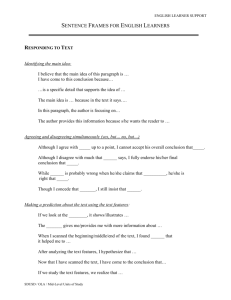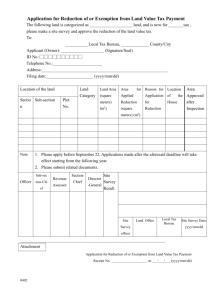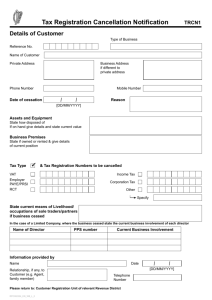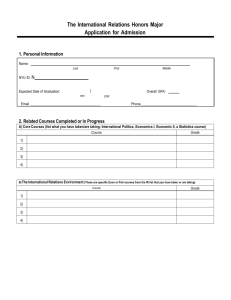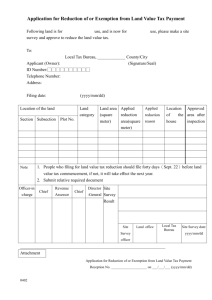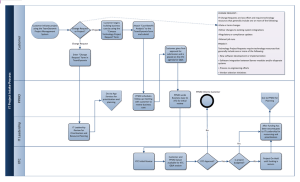Operational Level Agreement (OLA) Template
advertisement
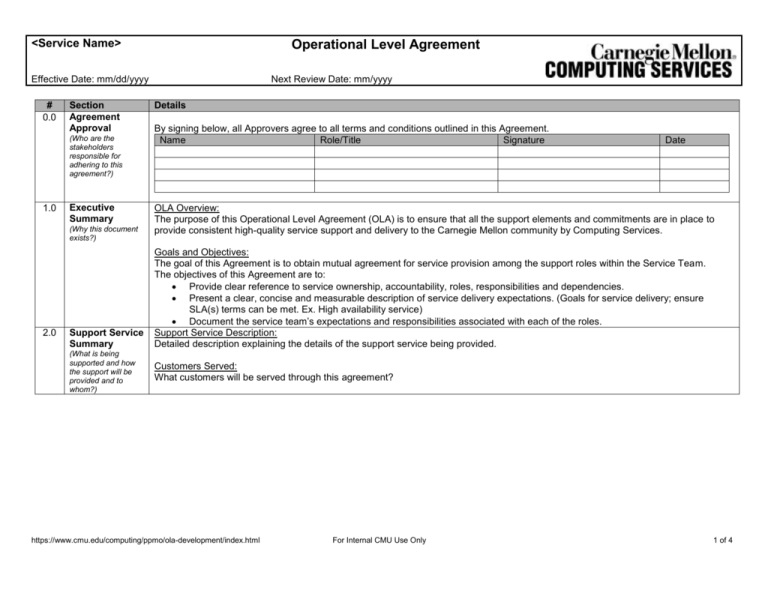
<Service Name> Operational Level Agreement Effective Date: mm/dd/yyyy # 0.0 Section Agreement Approval (Who are the stakeholders responsible for adhering to this agreement?) 1.0 Executive Summary (Why this document exists?) 2.0 Support Service Summary (What is being supported and how the support will be provided and to whom?) Next Review Date: mm/yyyy Details By signing below, all Approvers agree to all terms and conditions outlined in this Agreement. Name Role/Title Signature Date OLA Overview: The purpose of this Operational Level Agreement (OLA) is to ensure that all the support elements and commitments are in place to provide consistent high-quality service support and delivery to the Carnegie Mellon community by Computing Services. Goals and Objectives: The goal of this Agreement is to obtain mutual agreement for service provision among the support roles within the Service Team. The objectives of this Agreement are to: Provide clear reference to service ownership, accountability, roles, responsibilities and dependencies. Present a clear, concise and measurable description of service delivery expectations. (Goals for service delivery; ensure SLA(s) terms can be met. Ex. High availability service) Document the service team’s expectations and responsibilities associated with each of the roles. Support Service Description: Detailed description explaining the details of the support service being provided. Customers Served: What customers will be served through this agreement? https://www.cmu.edu/computing/ppmo/ola-development/index.html For Internal CMU Use Only 1 of 4 <Service Name> Operational Level Agreement Effective Date: mm/dd/yyyy 3.0 Support Service Roles and Responsibilities (Who is responsible for what to support the service?) 4.0 Service Availability Next Review Date: mm/yyyy The following roles are necessary for supporting this service. These members represent the primary stakeholders associated with this OLA and are responsible for the deployment and ongoing support of the agreement. Any of the following stakeholders may initiate OLA review. Role Responsibilities Name/Group(s) Contact Information Primary Support Hours Service Owner The individual responsible for guiding the strategic direction of the service Service Manager The individual who has the authority to make decisions regarding the day-to-day operations of the service First Line Receives initial contact from the Customer Support customer and provides initial support to incidents and service requests Second Line Provides in depth troubleshooting Customer Support of the incident or request after first line customer support Documentation Provides the customers Manager documentation about the service Communication Provides the customers official Manager communications regarding the service Additional Additional Additional Additional 24 x 7 x 365 or OTHER (When is the service available?) 5.0 Support Hours M – F 7:00am – 7:00pm or OTHER (When is support available to the users?) https://www.cmu.edu/computing/ppmo/ola-development/index.html For Internal CMU Use Only 2 of 4 <Service Name> Operational Level Agreement Effective Date: mm/dd/yyyy 6.0 7.0 Maintenance Windows Standard Service Maintenance Window: What are the known standard maintenance windows for this service? (What are the maintenance windows for the service?) Critical No Maintenance Periods: When should not maintenance be scheduled due to critical business operations? Incident Response Times (These are standard response times between escalations.) 8.0 Next Review Date: mm/yyyy Priority Level Critical High Normal Definition Customer(s) are unable to work due to a 24 x 7 x 365 service (per Service Portfolio) being unavailable. Customer(s) are unable to work or their work performance is degraded with a workaround due to a service being unavailable. Customer(s) are able to work and work performance is not impacted or the customer states there is no immediate need for response. Escalation Process Standard Hours Escalation Process: Insert the escalation process flow diagram during standard business hours. (How are incidents escalated through the support process?) Off-Hours Critical Escalation Process: Insert the escalation process flow diagram for critical incidents during off-hours. Max. Response Time 1 hour 4 business hours 1 business day Problem Management Escalation Process: Insert the escalation and management process for incidents that become systemic problems. 9.0 Support Metrics (What metrics will be collected to measure the support process?) 10.0 Metric data will be collected and formatted per the reporting frequency by the PPMO. The Service Team will analyze the metric data at the regularly scheduled service team meetings. Metric Total # of incidents % of First Time Resolution Resolution Time Data System Responsible Party Support Team Meeting The PPMO will schedule and facilitate the Support Team Meetings per the following frequency. (How often should the support teams defined in section 3.0 Quarterly, Every Semester https://www.cmu.edu/computing/ppmo/ola-development/index.html For Internal CMU Use Only Reporting Frequency Quarterly Quarterly Quarterly 3 of 4 <Service Name> Operational Level Agreement Effective Date: mm/dd/yyyy Next Review Date: mm/yyyy meet to discuss the support metrics and process?) 11.0 OLA Review Conditions (What conditions trigger a review of the OLA?) 12.0 OLA Termination Conditions OLA Change Triggered Review: The following changes will trigger a review of the OLA. When one of the following occurs or is anticipated it is the team member’s responsibility to contact the Information Process Specialist who will coordinate the review process. Any change to availability of the service/a service component. The addition or removal of a role, or changes to role definitions in the OLA will trigger a review. Team member changes (a team member changes responsibilities or is no longer responsible for a role) Changes in business continuity requirements for the service. Delivery of tactical projects concerning the service or one of its components. Completion or changes to the service portfolio document for this service (including addition and removal of service components and changes in dependent systems). Metric Trigger Review: Any unplanned full outage of the service. Any outage that lasts longer than 8 hours. Consistent failures of a component within the system. Termination of service is always a condition for the termination of this OLA. All other questions about termination need to go through the OLA review process managed by the PPMO. If any stakeholder raises question about viability of the OLA they should contact the PPMO to discuss. (How does an OLA get terminated?) A Rev. # Addendum Revision Date Add additional supporting information here. Description of Change https://www.cmu.edu/computing/ppmo/ola-development/index.html Change Authors For Internal CMU Use Only 4 of 4


